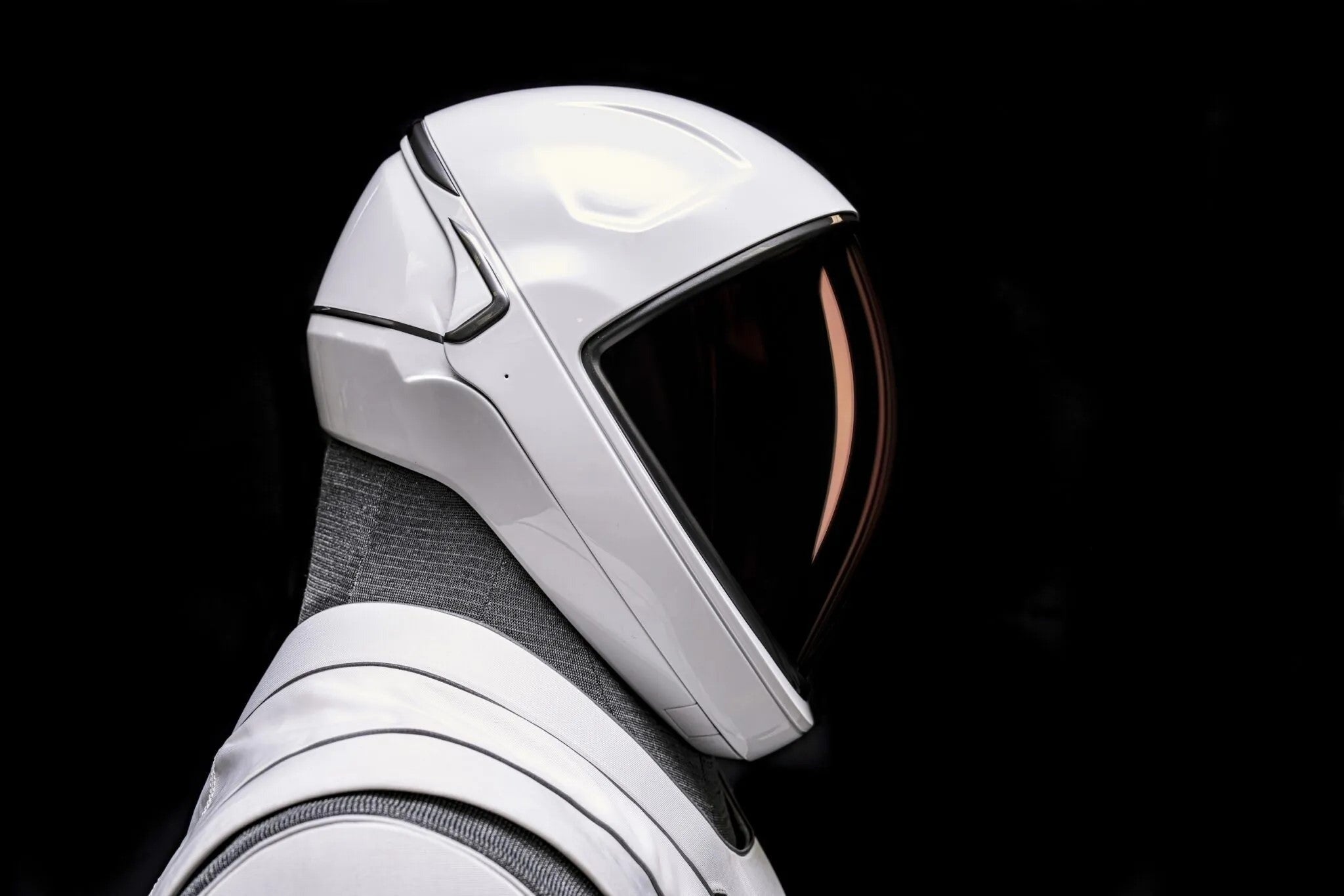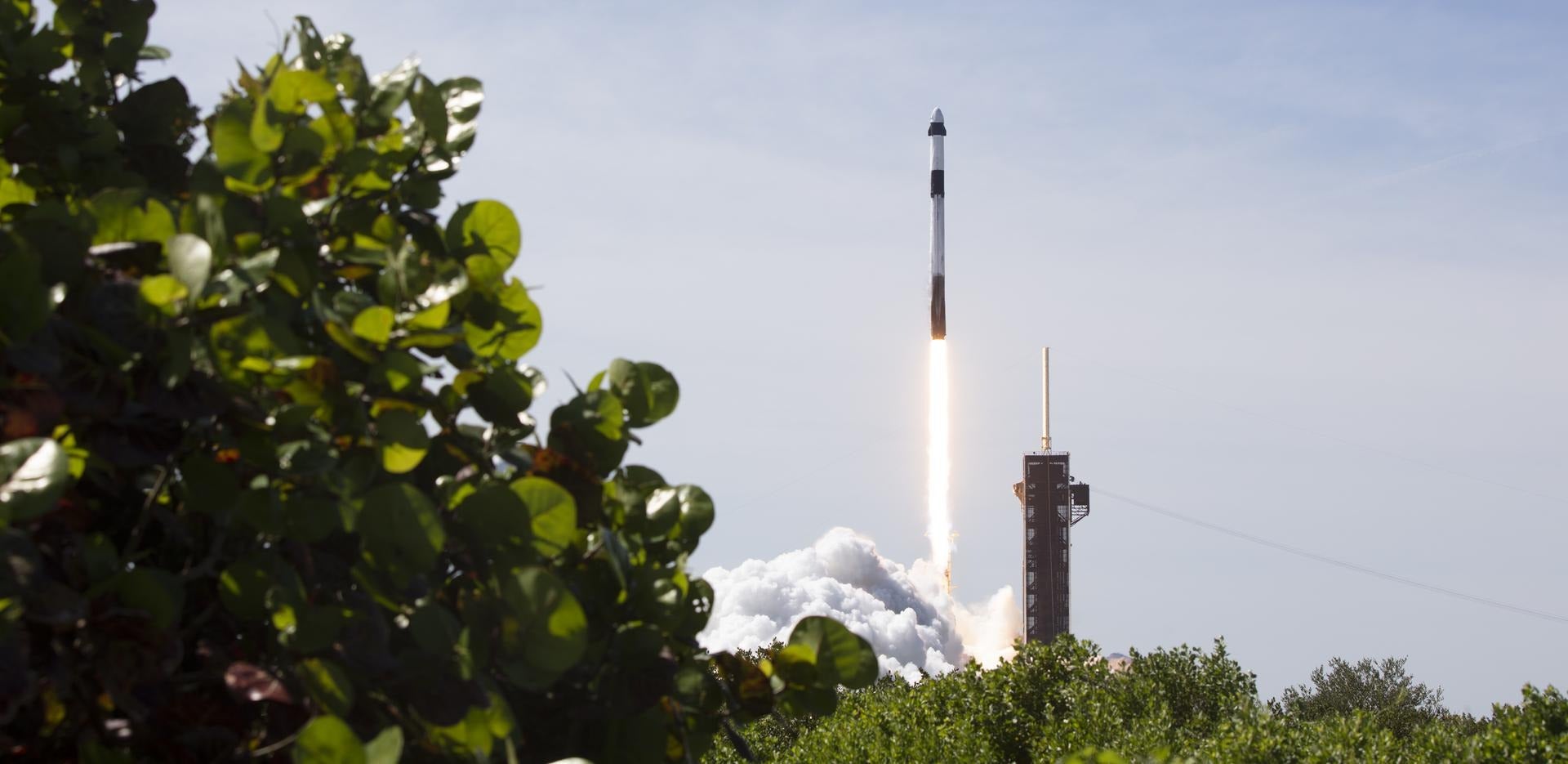
SpaceX’s newly unveiled extravehicular activity (EVA) spacesuit will allow astronauts to conduct spacewalks during Polaris Dawn. Credit: SpaceX.
A planned SpaceX mission, which is expected to include the first attempt at a commercial spacewalk and fly humans to heights within Earth’s orbit never before reached, received a major boost over the weekend.
SpaceX on Saturday unveiled its first-generation extravehicular activity (EVA) spacesuit, which will be donned by astronauts aboard the Polaris Dawn mission, scheduled for no earlier than this summer. Polaris Dawn—a five-day, four-person orbital mission to research human health both in space and on Earth—is the first of three potential human spaceflights under the Polaris Program.
SpaceX and entrepreneur Jared Isaacman, who founded the program in February 2022, held a discussion accompanying the announcement on social media platform X, formerly Twitter, which SpaceX CEO Elon Musk acquired in October..
While the mission has no firm launch date, SpaceX on Saturday confirmed that Polaris Dawn would be the next crewed mission the company will fly.
What Is Polaris?
The Polaris Program is the brainchild of Isaacman, the billionaire CEO of integrated payments provider Shift4 who is also a pilot and astronaut, with more than 7,000 flight hours and multiple experimental and ex-military aircraft ratings. Isaacman in 2012 founded Draken International, a private air force that trains pilots for the U.S. Armed Forces.
Isaacman purchased flights from SpaceX in February 2022 to launch the program and is funding Polaris Dawn himself.
Named after the constellation of three stars more commonly known as the North Star, or Polaris, the program comprises three potential missions, one for each star. The effort aims to rapidly advance human spaceflight capabilities with an eye toward future missions to the moon, Mars, and beyond. Simultaneously, it will raise funds and advance research into issues facing humanity on Earth, such as cancer.
Polaris Dawn, the first of the three missions, was announced in 2022 and expected to fly later that year. It has since been delayed multiple times, most recently from February to mid-2024, due in part to SpaceX’s development of the specially designed EVA spacesuits.
Polaris Dawn and a second mission without a timeline, simply called Mission II, will be flown using SpaceX’s Falcon 9 rocket and Crew Dragon capsule. Both vehicles are already in use by NASA and a handful of commercial customers, such as Axiom Space.
Falcon 9, a reusable two-stage rocket, is the world’s first orbital class reusable rocket and has been lauded for driving down launch costs in flying 330 times. Crew Dragon, which is capable of carrying up to seven passengers, in 2020 restored NASA’s ability to ferry astronauts to and from the International Space Station (ISS) with the first Commercial Crew rotation mission. It has flown a total of 46 missions, visiting the ISS on 42.
Polaris is expected to culminate in a third mission comprising the first crewed flight of SpaceX’s Starship, the largest and most powerful rocket ever built. Like Falcon 9, the spacecraft is designed to be fully reusable and has so far attempted three orbital test flights, each more successful than the last.
Isaacman has been outspoken about Polaris’ aim to make human spaceflight accessible to all. The new SpaceX suits, for example, are designed to fit a range of body types and accommodate all spacewalkers.
At the same time, the billionaire aviator is focused on solving problems on Earth. Since its founding, Polaris has worked closely with St. Jude Children’s Research Hospital and helped fund research into childhood cancer.
Civilians in Space
Polaris Dawn is notable for its four-person crew, which includes the first SpaceX employees expected to actually reach space.
Mission specialist Sarah Gillis oversees the company’s astronaut training program, while mission specialist and medical officer Anna Menon manages crew operations. Gillis, trained to be a classical violinist, joined SpaceX in 2015, while Menon is a seven-year NASA veteran. But both have been part of past Crew Dragon flights. Menon in particular was influential in developing Dragon’s crew and emergency response capabilities.
Joining the SpaceX employees will be pilot Scott Poteet, a retired Air Force lieutenant colonel with more than 3,200 flying hours in the F-16, A-4, T-38, T-37, T-3, and Alpha Jet.
Isaacman himself will serve as Polaris Dawn mission commander, a role he also filled for SpaceX’s 2021 Inspiration4 mission: the first all-civilian mission to space. Poteet, who previously served in roles at Isaacson’s companies Shift4 and Draken, was mission director for that flight, which raised $240 million for St. Jude.
To prepare for Polaris Dawn, crewmembers lived inside the decompression chamber at NASA’s Johnson Space Center in Houston for two days, summited the 16,800-foot peak of Illinizas Norte volcano in Ecuador, and experienced 9 Gs of force while training on three different kinds of fighter jets.
The mission will launch from Launch Complex 39A at Kennedy Space Center in Florida. The crew will spend up to five days in orbit, performing about 40 experiments and testing of hardware and software. Like Inspiration4, it is a charitable effort, with the goal of raising additional funds for St. Jude.
“Fifty or 100 years from now, people are going to be jumping in their rockets, and you’re going to have families bouncing around on the moon with their kids at a lunar base,” said Isaacman in an article on the St. Jude website. “If we can accomplish all of that, we sure as heck better tackle childhood cancer along the way.”
Polaris Dawn aims to fly higher than any SpaceX Dragon mission to date, a height that hasn’t been reached since the end of the Apollo program half a century ago.
The crew will also attempt to reach the highest Earth orbit ever flown. Isaacman during the discussion on X said the mission will target an apogee of 1,400 kilometers, or about 870 miles, more than double the orbital height reached by Apollo 17. That orbit would place the crew just inside the Van Allen radiation belt, where it hopes to research effects of spaceflight and space radiation on human health.
“The benefit of being at this high altitude is that we can better understand the impacts of that environment…on both the human body…as well as on the spacecraft,” said Menon during the discussion on X.

Suit up on Polaris Dawn
The Dragon capsule will complete seven elliptical orbits until reaching its apogee before descending to a circular orbit at about 700 kilometers (435 miles). At that altitude, crewmembers will attempt the first commercial spacewalk. It would also be the first time four astronauts have been exposed to the vacuum of space at the same time, according to SpaceX.
The spacewalk will mark the first use of SpaceX’s EVA spacesuit in low-Earth orbit, a key milestone that is expected to inform future iterations of the design for long-duration missions.
It’s an evolution of SpaceX’s Intravehicular Activity (IVA) suit that has been modified to enable both intra and extravehicular use. In other words, personnel won’t need to change clothes when moving from the confines of the spacecraft to the harsh environment of space.
The EVA suit adds greater mobility, seals and pressure valves, a helmet camera, and textile-based thermal material, which regulates suit temperature and can be controlled using a dial. Boots were constructed from the same thermal material used to shield Falcon and Dragon from exposure.
“There was a lot of work on both the materials of the suit, developing a whole new layer that we needed to add for thermal management as well as looking at the thermal condition for the crewmembers themselves, and making sure that they were at a comfortable temperature inside the suit,” said Chris Drake, manager of SpaceX’s spacesuit team, on Saturday.
The 3D-printed helmet incorporates a new visor designed to reduce glare as well as a state-of-the-art, heads-up display (HUD). The HUD is active only during spacewalks and displays spacesuit pressure, temperature, and humidity, as well as a mission clock to track how long the astronauts are exposed to the vacuum of space.
Already, SpaceX is developing a second-generation EVA suit for missions to the moon and Mars. It estimates that millions of suits will be required to one day build a lunar base or Martian city.
“This is important because we are going to get to the moon and Mars one day, and we’re going to have to get out of our vehicles and out of the safety of the habitat to explore and build and repair things,” Isaacman said during the discussion on X.
The Dragon capsule has also required modifications to prepare for the landmark spacewalk. SpaceX on Saturday said a structure called “Skywalker” has been attached near the capsule’s hatch to act as a mobility aid. Handrails and foot rails have been installed inside the spacecraft, with a ladder interface added to the hatch opening.
SpaceX also installed a cabin pressurization system that allows the interior of the capsule to withstand the vacuum of space as air is sucked out during the spacewalk. A repressurization system will stabilize it once the astronauts return.
Why Polaris Dawn matters
In addition to achieving the first commercial spacewalk and the highest orbital altitude ever recorded, Polaris Dawn hopes to test Starlink laser-based communications in space for the first time. Data from the test could help develop space communications for future missions.
In addition, Polaris and SpaceX selected 38 scientific experiments from 23 partner institutions—including NASA, the U.S. Air Force Academy, and Embry-Riddle Aeronautical University—intended to advance the understanding of human health in space and on Earth.
The crew will use ultrasound to study decompression sickness, for example, and will research spaceflight associated neuro-ocular syndrome: a disease unique to humans who fly in space that can have severe debilitating effects. Upon landing, astronauts will undergo tests to study anemia—an unavoidable effect of traveling to space—and other conditions that might impact humans on Earth.
The scientific aims of the Polaris Program differ from the commercial spaceflight ventures offered by companies such as Blue Origin and Virgin Galactic, which could be classified more aptly as space tourism operations.
Tickets for those companies’ orbital and suborbital offerings, some of which involve research, can range from the hundreds of thousands of dollars to the millions. Isaacman and SpaceX’s Inspiration4, meanwhile, raised a quarter of a billion dollars for cancer research.
Isaacman has been particularly outspoken when it comes to accessibility in spaceflight. And by taking on much of the risk himself, the billionaire businessman has lessened the pressure on SpaceX. Isaacman’s funding of Polaris Dawn has allowed the company to focus on developing the spacesuits and other technology necessary to ensure the mission runs smoothly.
Polaris Dawn also represents a critical juncture for SpaceX’s Starship, the lynchpin of the company’s planned human spaceflight offerings. The largest rocket ever built is not quite ready to fly humans. But when it is, the third Polaris mission is expected to be its maiden voyage.
Editor’s note: This article first appeared on flyingmag.com.

